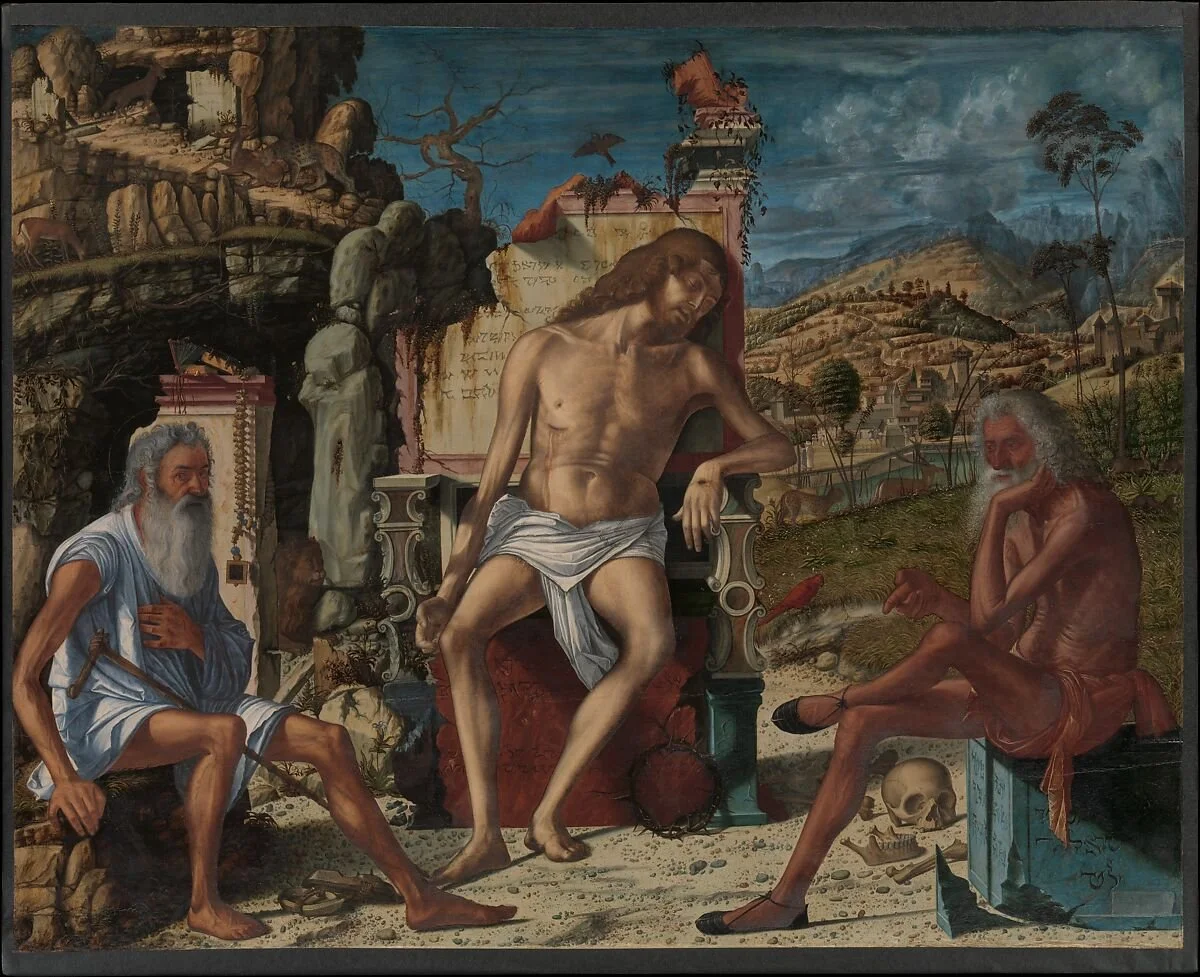G606
Venice
#5
Venice #5
Trade and Transformation in Venice
The Adoration of the Shepherds, Andrea Mantegna
Shortly after 1450
Hollandaise
Mantegna born in Isola di Carturo 1430/31, died in Mantua 1506
May commission by Borso d’Este, style seems responding to Netherlandish art in Ferrara.
Borso d’Este (1413-1471): First Duke of Ferrara and Moderna. Secured his titles from both Emperor Frederick III in 1452 and Pope Paul II in 1471.
Espagnole
In clothing tattered from years of labor
Virgin and Child depicted as portal between the natural and divine world: blue and gold robe extend into cloud filled with cherubs who sails around the newborn.
Velouté
Are the different soil texture in the foreground a foreshadowing of Christ’s fate / coming phases of human fate?
The Meditation on the Passion, Vittore Carpaccio
ca. 1490
Hollandaise
Old Testament prophet Job sitting on pseudo-Hebrew and across St Jerome wrote. A commentary on Book of Job.
Job: wealthy God-fearing man with a comfortable life and a large family. God discusses Job's piety with Satan. Satan rebukes God, stating that Job would turn away from God if he were to lose everything within his possession. God decides to test that theory by allowing Satan to inflict pain on Job. The rest of the book deals with Job's suffering and him successfully defending himself against his unsympathetic friends, whom God admonishes, and God's sovereignty over nature.
Velouté
St. Jerome painted before Christ; Christ’s right foot shortened to avoid overlap.
Madonna and Child with Saints Francis and Clare.
Cima da Conegliano(Giovanni Battista Cima)
ca. 1510
Hollandaise
Conegliano: Provincia di Treviso, Comuni del Veneto
Francis and Clare were from Assisi. Clare, a noblewoman, drawn to Francis’s preaching; joined his order.
Building may be Basilica of Saint Clare Assisi
Painted in Cima’s late career, the work preserves Bellini’s 1480s style. No surprise a false Bellini signature was later added.
Three Saints: Roch, Anthony Abbot, and Lucy. Cima da Conegliano
ca. 1513
Hollandaise
Center: Anthony Abbot, patron of infectious disease, identified by a small black pig (Symbol of At. Anthony)
Left: St. Roch, patron of victims of plague, pointing a bubo on his leg
Right: St. Lucy, patron of blind, identified by her illuminated lamp
The work may be for Hospital Brothers of St. Anthony
Madonna and Child. Carlo Crivelli
ca. 1480
Hollandaise
Crivelli: Veneto
Symbols of good and evil throughout:
Apple and fly: sin
Cucumber and goldfinch: redemption and soul
One of Crivelli finest work, details show Flemish influence
Background turbaned figures may be Mamluks who controlled Jerusalem 1480s
Pieta. Carlo Crivelli
1476
Hollandaise
Originally from the 1476 Altarpiece (Demidoff Altarpiece / San Domenico Altarpiece) that was considered Crivelli’s masterpiece.
1476 Altarpiece:
Dominican Church, Ascoli Piceno, Marche.
Houses another Crivelli piece, Saint Peter Martyrdom Altarpiece
One panel in the MET, nine panels in National Gallery London
Espagnole
A sob escaping Mary’s parted lips
St John Evangelist mirrors her wailing grief
Mary Magdalene absorbs the cruelty of his wound, holding up his hand in front of an illusionistically rendered tomb. Each strand of hair is rendered separately.
Christ as the Man of Sorrow. Marco Zoppo
(Gone from the MET Website?)
Hollandaise
Zoppo: born in Cento, Ferrara, Emilia-Romagna - died in Venice
Possibly the crown of an altarpiece
Zoppo trained same studio as Mantegna in Padua, but spent most career in Venice
One of the most eccentric 15c Italian painter
Espagnole
Hands overlapping a parapet to establish a closer link with viewer-workshipper
// his wiry, sometimes contorted, but always expressive figures was much appreciated by humanists and patrons
The Death of the Virgin. Bartolomeo Vivarini
1484
Hollandaise
St Lawrence and Stephen on either side
Landscape Barron left and green right - contrast death to life
Painted for the Certosa, Padua ; frame decorated with carved St Michael at top (where??)
Vivarini: From a painter family in Murano, he offers Venetian clients a more conservative style than that of Bellini - one influence by the linearity of Mantegna
Madonna Adoring the Sleeping Child. Giovanni Bellini
Early 1460s
Hollandaise
Early work of Bellini - hard linear quality is indent to his brother in law, Mantegna, and Donatello (studied with in Padua)
Painting suffer a strong abrasive cleaning
Espagnole
Sleep as a reminder of eventual death and sacrifice
Christ was placed on a ledge resembling an altar, doubles as a symbol of the Eucharist
Madonna and Child. Giovanni Bellini
Late 1480s
Hollandaise
parapet spectate from our everyday world
Madonna draws us with her gaze
dawn sky also a metaphor
Asymmetry composition: look ahead to the work of a Titian
Durer met Bellini in his 79s in his Venice visit: “ still the best in the art of painting”
Venetian frame of the period
Espagnole
A cloth of honor: a rich textile often displayed behind Mary has been pulled aside to reveal a distant landscape, where we witness the transition from dormant to verdant natures - metaphor for death and rebirth
The Holy Family with Saint Mary Magdalen. Andrea Mantegna
ca. 1495-1500
Hollandaise
Inspire by Roman funeral relief — portray deceased family members as touchingly bonded together
For the Gonzaga Mantua
In distemper, unusual medium that is water soluble when dry



